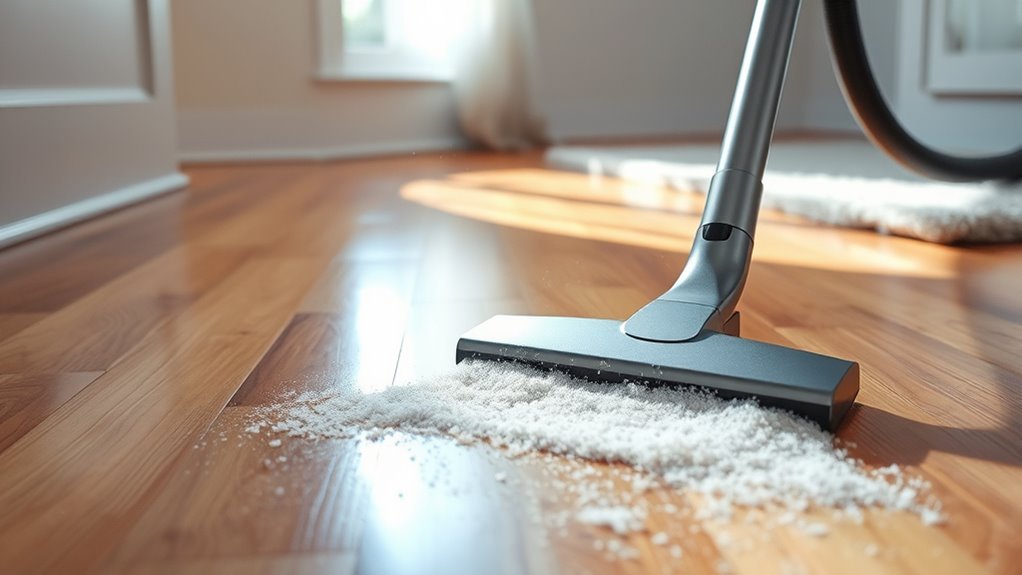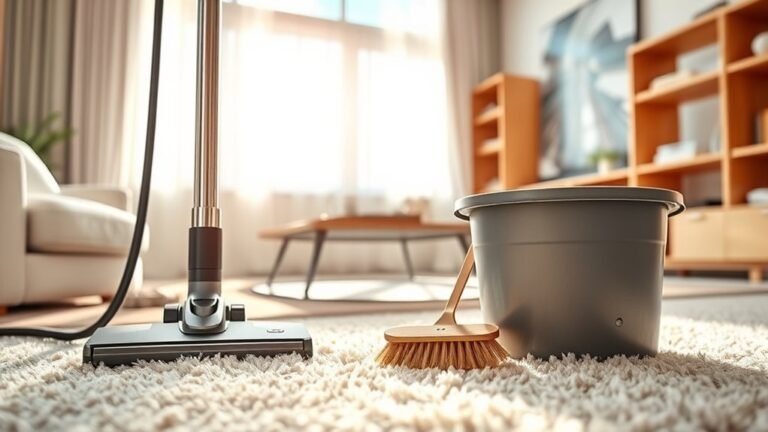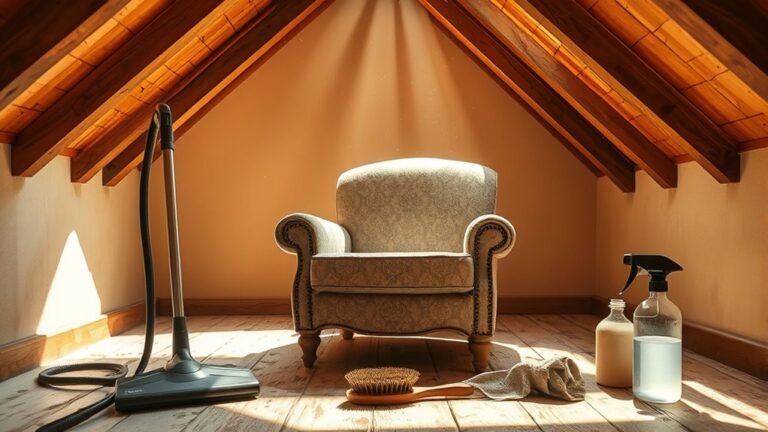How to Clean Allergens Floors
To clean allergen-filled floors effectively, use a vacuum with strong suction and a HEPA filter at least twice a week, moving slowly and covering all areas. Follow up with a damp microfiber mop, changing the water often to avoid spreading allergens. For carpets, deep clean regularly and use allergen-free, gentle cleaners. Managing pet dander with routine grooming and barriers helps too. Keeping up with these habits keeps your home fresher and healthier—there’s even more you can do for lasting relief.
Understanding Common Floor Allergens

Although you might not see them, common allergens like dust mites, pet dander, and pollen often settle deep into your floors. These allergen sources thrive in various floor materials, especially carpets and rugs where fibers trap particles. Hard surfaces such as wood or tile can also harbor dust and pet dander in cracks and grout lines. Understanding how these allergens interact with different floor materials empowers you to tackle them effectively. By knowing where allergens hide, you gain the freedom to maintain a cleaner, healthier space. Your choice of floor material influences how allergens accumulate and how you’ll manage them, so recognizing these differences is your first step toward a breathable home environment.
Choosing the Right Cleaning Tools
To effectively reduce allergens, you’ll want to pick a vacuum with strong suction and a HEPA filter to trap dust and pollen. When it comes to mopping, microfiber mops are great at capturing tiny particles without spreading them around. Choosing the right tools makes a big difference in keeping your floors truly clean.
Best Vacuum Types
Picking the right vacuum can make a huge difference in keeping your allergen floors truly clean. If you want freedom from constant dust, consider HEPA vacuums—they trap tiny allergens effectively. Upright vacuums are great for powerful deep cleaning, while canister vacuums offer flexibility for hard-to-reach spots. If you prefer convenience, cordless vacuums and handheld vacuums let you move freely without cords slowing you down. Robotic vacuums can handle daily maintenance hands-free, perfect for busy lifestyles. For heavy-duty needs, commercial vacuums deliver strong suction and durability. Bagless vacuums save you from buying bags and make emptying simpler, though you’ll want a model with good filters to avoid releasing allergens back into the air. Choose the vacuum that fits your space and routine to enjoy allergen-free floors effortlessly.
Effective Mop Options
Choosing the right mop can make a big difference in how well you tackle allergens on your floors. When picking mop types, consider microfiber mops—they trap dust and allergens effectively and require less water. Steam mops are another great option, using heat to kill bacteria without harsh chemicals, giving you freedom from allergenic residues. Avoid traditional string mops, which can spread dirt around. Pair your mop with appropriate cleaning solutions designed to neutralize allergens but stay gentle on surfaces. Opt for fragrance-free, hypoallergenic solutions to keep the air clear and your space fresh. By choosing the right mop and cleaning solutions, you’re not just cleaning—you’re reclaiming your home from allergens, giving yourself the freedom to breathe easy every day.
Vacuuming Techniques for Allergen Removal

Although vacuuming might seem straightforward, using the right techniques can make a big difference in reducing allergens effectively. To truly free your home from irritating particles, focus on vacuuming frequency and adopt strategic vacuuming patterns.
- Vacuum at least twice a week to keep allergens at bay.
- Use slow, deliberate vacuuming patterns to pick up more dust and pet dander.
- Overlap your strokes to avoid missing hidden allergen hotspots.
- Don’t rush—commit to thorough coverage for lasting relief.
Effective Mopping Methods for Hard Floors
When you mop hard floors effectively, you’ll remove allergens that vacuuming alone can’t reach. Start with the right mopping techniques: use a damp mop rather than a soaking wet one to avoid residue and potential damage. Microfiber mops are ideal because they trap dust and allergens efficiently. Change your mop water frequently to prevent redistributing dirt. For floor safety, always guarantee the floor dries quickly to avoid slips—use fans or open windows for ventilation. Avoid harsh chemicals that can irritate allergies; instead, opt for gentle, allergen-free cleaners. By mastering these mopping methods, you keep your floors cleaner and your environment healthier, giving you the freedom to enjoy a fresh, allergen-reduced space without worrying about hidden dust or unsafe cleaning practices.
Deep Cleaning Carpets and Rugs

To keep your carpets and rugs allergen-free, you’ll want to focus on proper vacuuming techniques that capture dust effectively. Using steam cleaning can further eliminate trapped allergens and refresh fibers deeply. Plus, knowing a few stain removal tips will help you tackle spots before they worsen.
Vacuuming Techniques
Since allergens can deeply embed in carpet fibers, mastering effective vacuuming techniques is essential for a thorough clean. You want to reclaim your space, free from irritants, and the right vacuuming approach will help you do just that. Here’s how to maximize your vacuum’s suction power and use smart vacuuming patterns:
- Vacuum slowly to allow suction power to lift deeply trapped allergens.
- Use overlapping vacuuming patterns to cover every inch without missing hidden dust.
- Change directions with each pass—go forward, then backward—to dislodge stubborn particles.
- Empty the vacuum bag or canister regularly to maintain peak suction and avoid spreading dust.
With these steps, you’ll breathe easier and feel the freedom of truly clean floors.
Steam Cleaning Benefits
Although vacuuming removes surface dust and allergens, steam cleaning goes deeper by penetrating carpet fibers to eliminate embedded dirt, bacteria, and allergens. When you use steam cleaning, you’re not just freshening up your floors—you’re achieving a thorough allergen reduction that can greatly improve your indoor air quality and overall comfort. Steam cleaning harnesses high temperatures to kill dust mites and mold spores without harsh chemicals, giving you a natural, effective way to clean. This deep clean frees you from worry about hidden allergens that might trigger allergies or respiratory issues. By choosing steam cleaning, you’re investing in a cleaner, healthier home environment that supports your desire for freedom from allergens and their effects, making your floors truly clean from the inside out.
Stain Removal Tips
When dealing with stubborn stains on carpets and rugs, acting quickly can make all the difference in preventing permanent damage. Different stain types call for specific removal techniques, so knowing what you’re up against frees you from frustration. Here’s how to tackle those pesky spots:
- Identify the stain type – Whether it’s wine, pet accidents, or grease, pinpointing the cause guides your approach.
- Blot, don’t rub – Gently blot the area with a clean cloth to avoid spreading the stain.
- Use natural solutions – Try a mix of vinegar and baking soda for many stains, preserving your freedom from harsh chemicals.
- Test removal techniques on a hidden spot – Always check first to protect your carpet’s fibers and colors.
These steps empower you to reclaim your clean, allergen-free space.
Using Air Purifiers to Reduce Airborne Allergens
Many air purifiers can considerably cut down the amount of airborne allergens in your home, making the air easier to breathe. Choosing the right air purifier types is key—HEPA filters are excellent at trapping pollen, dust mites, and pet dander. Some models combine HEPA with activated carbon filters for added odor control. Keep in mind that your purifier’s effectiveness depends on consistent filter maintenance. Dirty filters can reduce airflow and allow allergens to circulate freely. Make sure you check and replace filters as recommended, usually every 6 to 12 months. Position your air purifier in rooms where you spend most of your time for maximum benefit. By using the right purifier and maintaining it well, you’ll enjoy cleaner air and greater freedom from allergy symptoms.
Best Cleaning Products for Allergy-Prone Homes
Keeping airborne allergens in check with air purifiers is a great start, but controlling allergens on your floors and surfaces is just as important. To truly free your home from irritants, choose cleaning products that respect your health and environment. Here are the best options for allergy-prone homes:
- Hypoallergenic detergents—gentle yet effective, minimizing chemical triggers.
- Natural cleaning solutions—like vinegar or baking soda, safe and powerful.
- Microfiber mops and cloths—trap dust and allergens without spreading them.
- Fragrance-free, non-toxic sprays—clean without adding irritants to the air.
Managing Pet Dander on Floors
Although pet dander is a common allergen, you can reduce its impact on your floors with consistent care. Start by committing to regular pet grooming—brushing and bathing your furry friend often minimizes loose hair and dander before it settles. Using allergen barriers like washable rugs or floor mats in high-traffic pet areas helps trap dander, preventing it from embedding deep into your flooring. When cleaning, focus on methods that pick up fine particles, such as vacuuming with a HEPA filter or damp mopping hard floors to avoid stirring allergens into the air. By combining pet grooming with strategic allergen barriers, you’ll create a cleaner, more breathable space that lets you enjoy your freedom without the constant worry of pet-related allergens invading your home.
Preventing Allergen Buildup With Regular Maintenance
To keep allergens from piling up, you’ll want to dust your floors daily using microfiber cloths or mops that trap particles effectively. Choosing cleaners designed to reduce allergens can also make a big difference in maintaining a healthier environment. Regular maintenance like this helps keep your floors fresh and your air cleaner.
Daily Dusting Techniques
When you make daily dusting a habit, you greatly reduce the buildup of allergens on your floors. Sticking to simple daily routines frees you from sneezing fits and constant discomfort. Using the right dusting tools makes the job quick and effective, giving you more control over your environment.
Here’s how to keep allergens at bay:
- Choose microfiber dusters—they trap dust instead of spreading it around.
- Dust in one direction to avoid scattering particles.
- Start from higher surfaces and work your way down to floors.
- Empty or clean dusting tools regularly to prevent recontamination.
Choosing Allergen-Reducing Cleaners
Keeping your floors free from dust is a great start, but the cleaners you choose play a big role in preventing allergens from piling up again. You’ll want to opt for products with natural ingredients that effectively break down dirt without leaving harmful residues. Eco friendly options not only protect your health but also support a cleaner environment, giving you freedom from harsh chemicals. Look for cleaners labeled hypoallergenic or specifically designed to reduce allergens. Regularly using such products helps maintain a fresh, breathable space where allergens don’t stand a chance. By choosing wisely, you take control over your home’s air quality and create a safe sanctuary without sacrificing convenience or your commitment to sustainability.
Tips for Maintaining Allergen-Free Floors Year-Round
Although allergens can settle quickly, you can greatly reduce their presence by sticking to a consistent cleaning routine. Identifying allergen sources like dust, pet dander, and pollen is key to freedom from sneezing fits. Seasonal cleaning helps you tackle specific allergens when they’re most active, giving you control all year.
Consistent cleaning and pinpointing allergens like dust and pollen are essential for year-round relief from sneezing.
Here are four tips to keep your floors allergen-free:
- Vacuum regularly with a HEPA filter to trap tiny particles.
- Mop floors weekly using allergen-reducing cleaners.
- Remove shoes at the door to avoid bringing in outside allergens.
- Use door mats and wash them frequently to catch dirt and pollen.
Frequently Asked Questions
Can Allergens on Floors Trigger Asthma Attacks?
Yes, allergens on floors can definitely trigger asthma symptoms. When you breathe in dust, pet dander, or pollen trapped in carpets or on hard floors, it can act as allergen triggers, causing your airways to tighten and making it hard to breathe. If you want to enjoy your freedom without constant asthma attacks, keeping your floors clean is key to minimizing these triggers and maintaining better respiratory health.
How Often Should I Replace My Vacuum Filter?
You should replace your vacuum filter every 3 to 6 months, but it really depends on the filter type and how often you use your vacuum. HEPA filters, for instance, often need more frequent maintenance to keep allergens at bay. Keeping up with vacuum maintenance not only extends your vacuum’s life but also guarantees you’re breathing cleaner air. Don’t wait until you notice a drop in suction—swap filters regularly for the best freedom from dust and allergens.
Are Natural Cleaning Products Effective Against Allergens?
Think of natural cleaners as gentle warriors in your battle for allergen removal—they’re effective but may need a bit more elbow grease. They often contain plant-based ingredients that fight allergens without harsh chemicals, giving you peace of mind and freedom from toxic residues. While they can be great, you might need to combine them with regular cleaning habits to truly keep allergens at bay and enjoy a fresher, healthier space.
Does Humidity Affect Allergen Buildup on Floors?
Yes, humidity levels play a big role in allergen buildup on floors. When humidity’s high, dust mites and mold thrive, increasing allergen types you might face. Too low, and allergens like pet dander can become more airborne, making you feel trapped. By controlling humidity, you’re freeing yourself from persistent allergens and creating a more comfortable space. So, keep those levels balanced to enjoy your home without sneezing or discomfort.
Can Allergen-Resistant Flooring Materials Reduce Cleaning Frequency?
You’ll find that allergen-resistant flooring options like vinyl, tile, or sealed hardwood can definitely support allergen reduction in your home. These materials don’t trap dust and pollen as much, meaning you won’t have to clean as often. Choosing the right flooring lets you enjoy a fresher space with less hassle, giving you more freedom from constant upkeep while keeping allergens at bay.






